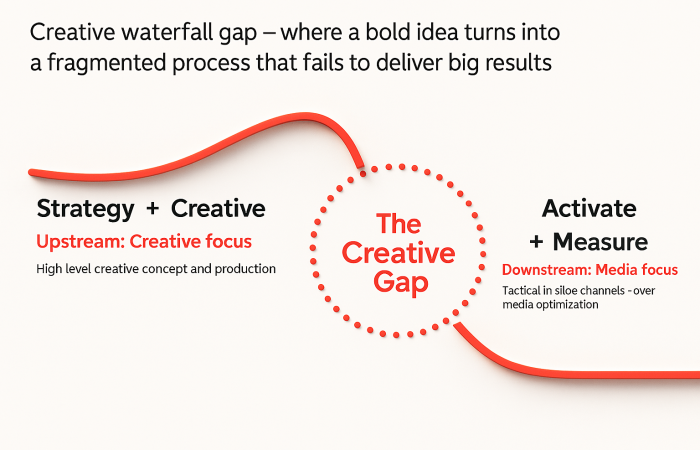 Go back to Blog
Go back to Blog
Yannick Wittenauer
Published on 2 April 2025

“This video was made for TV, and now I have to reverse-engineer it for YouTube, Meta, and TikTok…”
Sounds familiar?
The brand team drops a polished 30-second film on your desk, ready for launch. It’s cinematic. Emotional. Beautifully produced.
And now… it’s your job to make it perform across fast-paced digital environments.
But here’s the catch: these platforms don’t work like TV.
They demand instant attention, platform-specific guidelines formats, and audience-aware content.
The challenge? Avoid the creative waterfall gap.

Traditional 30s spots are structured like a story arc—with a buildup, middle, and payoff.
But on digital, you’ve got 3 seconds (max) to hook attention. When a TV-style ad is repurposed for social feeds or YouTube pre-rolls without rethinking structure, the result is often disappointing: skipped ads, low engagement, poor ROI.
“The most important thing is to stop thinking that the same video can work everywhere.”
— Converteo & VideoRunRun
Each platform has its own rules of engagement—its own language.
Creative Intelligence helps you decode what works where using performance-linked creative data. It doesn’t ask you to kill the hero film—it helps you break it into platform-audience-objective perfect segments.
In its Multiplier effect 2025 CMO guide to brand-building in the performance era, WARC advises marketers to stop thinking “campaign” and start thinking “platform.”
Most brand strategies still operate on a campaign-first model: build a single big idea, cut it down into a few formats, and launch it across all channels.
But main video platforms don’t follow that logic. They’re not just media—they’re ecosystems, each capable of supporting awareness, engagement, and conversion.
Meta, YouTube, TikTok—they each have specific guidelines, tailored pacing, and a creative arc that fits how users scroll, watch, and act. If your asset wasn’t designed to work across those platforms, you’re leaving performance on the table.
“In this world, a cut-down TV ad is less likely to work than a bespoke ad for a given platform.”
— WARC, Plan for Creative Fragmentation
The issue isn’t about media targeting. It’s about creative that’s disconnected from the user journey within each platform.
That means:
That’s what makes platform-first thinking a creative advantage—not just a media one.
Creative Intelligence helps teams shift by bridging performance data with creative insights—per platform, per format, per objective.
The result? More relevant assets, better performance, and a bold brand message that’s finally in sync with the digital platform.
Creative is often treated like a single asset—not a dynamic sum of multiple assets (sequences, music, texts, speed…) meant to evolve. A single or few “hero versions” are launched, boldly.
There’s a lack of structured experimentation, learning agenda, clear method to adapt or scale what performs best.
This leads to:
“Creative testing should be integrated from the beginning of campaigns, not just analyzed at the end.”
— Converteo & VideoRunRun
Creative Intelligence builds a bridge between creative, data, and performance teams. It makes creative measurable, testable, and adaptable—helping you build a culture of continuous creative improvement.
The result? Faster learning, smarter decisions, countless iterations over time based on positive signals.
Creative Intelligence is a data-driven approach to understanding how every element of your ad—layout, length, call-to-action, talent, tone…—impacts performance across different platforms.
It doesn’t replace creativity. It AMPLIFIES it.
By using structured creative data and AI-powered analysis, CI helps:
Let’s explore how Creative Intelligence from VideoRunRun could unlock growth for your campaigns: Book a call or ask for your FREE predictive creative scoring.
Is Your Video Creative Ready for Success?
Secure your creative decisions with Predictive Scoring powered by AI and Data